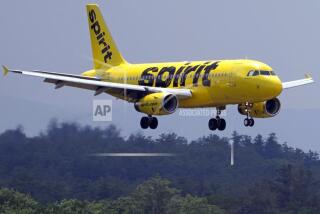AMR shares fall on American Airlines bankruptcy concerns
American Airlines parent AMR Corp. tumbled the most since 2003, triggering automatic trading halts, on growing concern the third-largest U.S. carrier may be forced to seek bankruptcy protection.
So-called circuit breakers to stop the rout from moving to other shares took effect seven times in less than an hour starting at about 12:58 p.m. in New York Stock Exchange composite trading. Fort Worth, Texas-based AMR plunged as much as 41 percent to $1.75, the lowest in more than eight years.
“These low-priced stocks tend to move fast, so it doesn’t take much to trigger it and then everyone sees that and piles on,” Joseph Saluzzi, co-head of equity trading at Themis Trading LLC in Chatham, New Jersey, said in an interview. “You add in the bankruptcy rumor, and people just start dumping immediately.”
AMR declined 98 cents, or 33 percent, to $1.98 at 4:15 p.m. on the NYSE, the worst one-day slide since March 2003. The circuit breakers were introduced after the stock market’s May 6, 2010, crash to keep losses in one security from snowballing.
The company has led declines this year among the largest U.S. airlines, plummeting 75 percent, and is headed toward a fourth consecutive annual loss. That is helping spur bankruptcy speculation as a slowing economy fuels investor belief that air travel will slump, said Ray Neidl, a Maxim Group LLC analyst in New York.
“The odds are better than 50-50 that we’re going into a recession,” Neidl said today in an interview. “If that’s the case, you’re going to start seeing some softness in demand come October, in the fourth quarter and next year.”
Neidl, who doesn’t rate the shares, said investors are concerned that AMR will burn through its cash reserves unless it can achieve deeper cuts in costs and seating capacity. He called American the “weak sister of the 10 big airlines.”
A Chapter 11 filing “is certainly not our goal or our preference,” said Andy Backover, an American spokesman. “We know we need to improve our results, and we have a sense of urgency as we work to achieve that.”
There was no company-driven news that caused the share volatility, Backover said in an e-mail.
AMR isn’t planning a bankruptcy filing, said a person familiar with the issue who didn’t want to be named because such discussions are private. The company expected to end the third quarter with cash and short-term investments of about $4.7 billion, including $475 million in restricted cash, according to a Sept. 21 regulatory filing.
The cost to protect against an AMR default soared, with credit-default swaps jumping 15.5 percentage points to 65 percent upfront, according to broker Phoenix Partners Group. That means it would cost $6.5 million initially and $500,000 annually to shield $10 million of debt from default for five years.
On Sept. 27, AMR sold $725.7 million of 10-year bonds backed by aircraft to refinance maturing debt. AMR paid the highest interest rates since 2009 to raise the cash.
“If AMR management were seriously considering a bankruptcy filing in the near-term, they probably would not have refinanced most of today’s $828 million debt maturity last week,” said Jeff Straebler, an aviation debt strategist at RBS Securities Inc. in Stamford, Connecticut.
AMR’s slide helped drag down the rest of the industry, as all 10 carriers in the Bloomberg U.S. Airlines Index fell.
United Continental Holdings Inc. dropped $2.27, or 12 percent, to $17.11 while US Airways Group Inc. fell 87 cents, or 16 percent, to $4.63 and Delta Air Lines Inc. declined 85 cents, or 11 percent, to $6.65.
American has blamed higher labor costs, as well as benefits that have increased more slowly than expected from business ventures with partners across the Atlantic and Pacific, in part for its failure to return to profit. The airline also has a fleet of older, less fuel-efficient planes that put it at a disadvantage when fuel prices rise.
The carrier, which is in contract talks with unions for its main work groups, sat out a round of consolidations that let peers expand their route networks while reducing costs.
American didn’t follow most of its rivals in seeking to reorganize debt through bankruptcy filings in the past decade. As a result, the carrier has retained pension obligations and retiree benefits that others shed in Chapter 11.
Pilot retirements from American have totaled at least 10 times the monthly average in September and October as employees sought to protect their pensions from a possible bankruptcy filing and declines in the broader stock market.
American is trimming some international flights starting this month to cover the loss of 240 pilots during the two months, meaning passengers will see minimal disruptions, the company said. American asked the pilots union to waive some work rules and sought voluntary delays of September vacations among pilots who fly Boeing Co. 777s to assure adequate staffing.
In July, the airline took steps to renew its fleet, taking advantage of $13 billion in financing from Boeing and Airbus SAS to order 460 new planes to be delivered in 2013 through 2022. AMR also has moved to spin off its American Eagle regional airline in a bid to lower rates American pays to have passengers flown from smaller cities to its hubs.
“There are a number of things going on that are potential positives,” said Michael Derchin, an analyst at Stamford, Connecticut-based CRT Capital Group LLC with a “fairly valued” rated on AMR. “Oil prices are coming down, you’ve got the spin, presumably soon, of Eagle, and labor talks are ongoing. There are a lot of things that would suggest that, on the margin, things could start to get better over time.”
More to Read
Inside the business of entertainment
The Wide Shot brings you news, analysis and insights on everything from streaming wars to production — and what it all means for the future.
You may occasionally receive promotional content from the Los Angeles Times.







